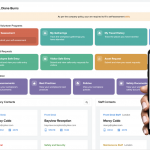A white paper by Fujitsu.
The role of IT in raising productivity, improving outcomes and supporting patient-centric services.
Introduction:
The healthcare industry today faces huge challenges, due to ever increasing demands. Healthcare professionals are under pressure to continually improve the services they offer
to care for a growing number of patients – often with inadequate resources.
In other industries, information and communications technology (ICT) solutions have been adopted to raise productivity and enable innovation, and are now widely
accepted as part of daily work practices. However, in the healthcare industry, although ICT is widely used, it has still not yet reached its full potential. Part of the reason
for this is that healthcare providers are typically more cautious than their counterparts in other industries; a sensible outlook given that they are dealing with human lives.
Nevertheless, the enormous challenges facing the healthcare industry are now forcing healthcare providers to seek better efficiencies in an effort to stretch limited funds further and keep up with new medical advancements.
There is compelling evidence to demonstrate that the adoption of health informatics results in improved patient safety and the delivery of a higher level of patient care. When ICT is introduced by healthcare providers, the result is that teamwork improves; information to assist with diagnosis is delivered faster; potential drug interactions and allergies are identified earlier; and health records are maintained more consistently and securely. By demonstrating the substantial savings that can be achieved through using
ICT in the healthcare industry, we believe that we can accelerate the deployment of new technologies to help healthcare providers tackle the challenge of stretching budgets further.
This paper looks at the current trends in healthcare, outlines some of the areas where ICT is being used to provide better healthcare services, and describes Fujitsu’s global healthcare experience.
Fujitsu’s Japanese heritage ensures our absolute commitment to the outstanding quality and timely delivery of our solutions. Our approach is to provide our customers with long-term support.
Our focus is to try to understand our customers’ issues in detail, from government policies through to the needs of individual organizations and end users. We also believe that we can learn from our customers and work with them to achieve optimal healthcare outcomes.
Chapter 1: What challenges are being faced in healthcare today?
Today, the healthcare industry faces a range of significant challenges in the delivery of patient care. These include rising healthcare costs, high patient expectations, resource management, emergency management, long-term planning and strategic investment.
Healthcare Costs:
Rapidly escalating healthcare costs are quickly becoming a key issue in many countries around the world. This is largely attributable to ageing populations and
the increased prevalence of chronic diseases.
According to a report by the National Institute of Population and Social Security Research in Japan, the percentage of people aged over 65 will increase to 25% by
2014. This trend is expected to continue, increasing to 50% by 2030.
As chronic diseases typically endure for an extended period of time and frequently reoccur, they are also a leading factor in increasing healthcare costs. In addition, these types of illnesses significantly reduce the quality of life for sufferers and adversely affect families who lose loved ones prematurely or who are left to care for those with disabilities.
Patient Expectations:
Patients today have much higher expectations of healthcare providers than they did before. Advanced communication channels – such as the media, call centers and the Internet – are now providing people with 24 hour access to services in the retail and financial sectors. This consumer expectation has flowed on to the healthcare sector where a similar level of service is wanted. However, up until now this consideration has been widely disregarded by healthcare providers. This attitude is now changing because of patients’ views becoming an important element in the evaluation of healthcare services.
Resource management:
Healthcare is a labor-intensive industry, with human resources being the most important component in the provision of healthcare services. However, the sector is
severely under-resourced due to a global skills shortage.
The increase in demand for healthcare services has made the recruiting and retaining of experienced and qualified staff a priority for healthcare organizations. This situation is expected to worsen as the first baby boomers begin to retire and the population continues to age.
Emergency management:
Healthcare services are required to manage medical emergencies around the clock. The World Health Report 2007 – A Safer Future: Global Public Health Security in the 21st
Century describes how the world is at increasing risk of disease outbreaks, epidemics, industrial accidents, natural disasters and other health emergencies which can rapidly threaten global public health. Never before in history has global public health been dependant on international cooperation and the willingness of all countries to act effectively in tackling new and emerging threats.
Long term planning and strategic investment:
Governments are facing a wide variety of challenges and pressures, especially the continuously rising cost of healthcare. An injection of additional funding is not sufficient to solve the problem. The answer will involve the development of good strategies which respond to the healthcare challenges and provide clarity for stakeholders.
In summarizing the various healthcare challenges, Jeff Smoot, National Director Health Solutions, Fujitsu Australia & New Zealand, said:
“Health funding is under pressure and long-term care and chronic disease care take an everincreasing slice of the budget. The increased pace of change in healthcare challenges both providers and professionals, and I am concerned that the focus on preventative medicine and chronic disease management may only shift the cost from one service to another without any real savings.”
“Individual care now comes from many different services in different locations and settings. IT solutions must be based on specific strategies around communication; collaboration and monitoring that are patient-centric.”
“Customers will achieve the efficiency gains required for sustainable health delivery by investing in linking professionals and presenting one patient record. We risk seriously lagging behind patient and citizen expectations – they will continue to escalate health as a serious political issue.”
Chapter 2: What will healthcare in the future look like?
Given these challenges, action must be taken to change the way that healthcare services are delivered. Complacency is no longer an option. Urgent and radical improvement is now imperative. Dramatic changes in the healthcare system are needed to empower, enhance and preserve vital resources. These changes include reducing waste, removing inefficiencies and optimizing entire processes.
Change in Delivery Methods:
Until now, most healthcare services have been provided separately by private doctors, hospitals, clinics, community centers and social welfare agencies. In the future, delivery methods are expected to become more patient focused and will utilize an integrated model that shares patient records, thus providing a continuum of care across all healthcare providers. The implementation of this new model, however, will only succeed if healthcare providers choose to collaborate.
The technology now available provides us with the opportunity to make a real difference by ensuring efficient and effective services are delivered to patients through the full use of available resources.
Chapter 3: How is ICT helping to meet these healthcare challenges?
When focusing on the future of the healthcare industry, it is difficult to see how these challenges can be overcome without the use of ICT. Healthcare organizations are in a race to adopt a fully functional health record system, which is broad, deep and longitudinal. It is therefore inevitable that ICT-enabled care will become standard practice to allow more services to be delivered with a smaller budget.
The move to convince healthcare organizations of their need for ICT is well under way. However, uptake of ICT solutions is still very slow despite evidence that clearly demonstrates how valuable ICT is in the healthcare sector. The healthcare solutions that Fujitsu delivers can benefit enormously.
Value-based thinking:
A key approach for accelerating investment in ICT is to quantify and convey to shareholders the benefits which can be attained. Clear evidence of return on investment (ROI) goes a long way toward creating a believer. ROI is not only about increased revenue or reduced costs – it can also factors such as error reduction, improved service delivery and better quality of care. This is important for all types of organizations. It is reasonable to expect ROI data to show that a return is achievable.
Technology-led process improvement:
Process improvement is the ongoing quest to identify and eliminate the main sources of problems. A unique process improvement management methodology, known as “Kaizen”, was developed by a Japanese automobile manufacturer and is well known not only in Japan, but also globally. Kaizen is now attracting a lot of attention in the healthcare sector. The methodology involves making improvements via incremental steps, rather than implementing changes all at once.
Today, many healthcare information systems are being significantly revamped to improve their effectiveness and efficiency, and also to allow costs to be monitored.
This process can be accelerated by implementing the Kaizen methodology and ICT.
Decision support:
By integrating a medical knowledge base with patient data, clinical decision support systems can be developed that provide case-specific advice to assist physicians and other healthcare professionals.
As clinical processes become more complex, an increasing number of healthcare organizations are adopting tools that offer decision support to improve patient outcomes and reduce errors. The implementation of effective clinical decision support systems is a challenging task involving interaction between technologies and organizations.
Data visibility, integrity and interoperability:
Healthcare organizations traditionally used systems that focused on single departments or functions. They are now facing the huge challenge of integrating these disparate systems. This is not only a problem for hospitals; primary, secondary, home and community carers are also affected. When these systems are integrated, the delivery of healthcare services is optimized, resulting in the best possible care of patients.
The data stored in the integrated system is updated daily and also assists with medical research. This is a powerful benefit for the future of medicine.
Security and privacy:
Data security and identity management in healthcare has never been more critical. In the US, for example, with the passage of the Health Insurance Portability and Accountability Act (HIPAA), healthcare organizations are now required to use two or more forms of authentication to access electronic health records and other sensitive data.
An accurate patient identification system not only helps organizations combat medical identity fraud but also helps to reduce the chance of medical errors occurring through the mistaken identify of patients. As healthcare organizations begin to adopt more automated clinical workflows and information sharing across departments, the issue of correct employee identification at each point of access plays an important role in ensuring operational efficiency while complying with government regulations.
Reducing errors:
Human beings, no matter how careful and conscientious, make mistakes. As the delivery of healthcare is complex, there are many opportunities for errors to occur. In addition, the high level of complexity makes it unrealistic to expect healthcare professionals to perform their jobs perfectly so that mistakes are avoided and patients are not harmed.
Also, to avoid being involved in litigation arising from mistakes, the tendency is for physicians to order excessive medical testing which is often expensive. This creates a vicious cycle in healthcare which prolongs treatment and stretches resources.
Patient safety has now become one of the most pressing healthcare challenges and ICT has the potential to contribute to better outcomes.
Driving research:
The genomic era is now a reality. Clinical opportunities for gene-based presymptomatic prediction of illness and adverse drug effects are emerging at a rapid pace, and the therapeutic promise of genomics has ushered in an exciting phase of expansion and exploration in universities and research institutions.
Fujitsu is a truly global organization with healthcare interests in a vast range of geographies. We deliver innovative ICT solutions that accelerate business change.
We focus on the inextricable links between business process and ICT design to offer solutions that are both leading-edge and effective. Our aim is to continually deliver business solutions that are supported by standardized ICT platforms and infrastructures, and that are individually tailored to suit each customer. We believe that our consistent approach allows us to build fruitful, long-lasting and trusted relationships with all of our customers.
Long-term view:
Fujitsu delivers exceptional customer service. This is achieved by looking at how we can help our customers to address their strategic goals in the long term. “Fujitsu works together with healthcare providers to improve services based on a partnership model. It’s all about us understanding the business challenges and working with healthcare professionals to solve them,” said Narutaka Nakao, Director of the Healthcare Solutions Group, Fujitsu Limited.
Global business support:
Fujitsu takes great pride in and places significant emphasis on our ability to continuously improve the healthcare industry as a whole. We have a solid global support structure in place that includes technology infrastructure, comprehensive support processes, and a network of skilled support professionals that collectively optimize worldwide knowledge management. Regional diversity is leveraged, ideas are shared, and other valuable knowledge assets are exchanged between practitioners in a global forum. This fluid exchange and expanding repository of industry, cultural, procedural, and other such knowledge, enables Fujitsu to promise the healthcare industry rapid and responsive support on a worldwide basis.
Fujitsu can help you to assess, redesign, update, maintain and increase the value of your business, and deliver extra benefits to your staff and patients.
Our solutions and services vary from country to country accordingly to specific regional requirements. To find out more please contact your local Fujitsu office.







